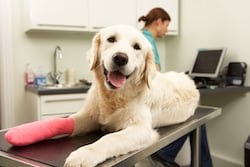 Increasingly, Extracorporeal Shockwave Therapy (ESWT) is being used successfully in veterinary settings and is most frequently used orthopedically to treat horses and small animals, including dogs and cats. Shockwave therapy is noninvasive and has been shown to stimulate bone regeneration.
Increasingly, Extracorporeal Shockwave Therapy (ESWT) is being used successfully in veterinary settings and is most frequently used orthopedically to treat horses and small animals, including dogs and cats. Shockwave therapy is noninvasive and has been shown to stimulate bone regeneration.
Kirsten Haeusler of Germany is an animal rehabilitation specialist with over a decade of experience in animal physical therapy. At her clinic in Stuttgart, she treats many orthopedic and neurologic cases referred by various veterinary clinics. Part of her research involves applying, improving, and investigating therapies, such as treatment on the underwater treadmill, a regular treadmill, shockwave therapy, pulsed electromagnetic field, and more, to benefit animals in post-illness rehabilitation and recovery treatments.
A 2016 study by Hafner et al. demonstrated that tibial nonunion in humans, when treated with shockwave therapy, was highly efficacious in an astounding 88% of cases. Therefore, this treatment was chosen as a preferred and safe treatment for a small dog weighing 22 pounds diagnosed with delayed nonunion of the canine tibia. Explore her case study with images shown in detail here.
Clinical Presentation and Findings
The dog was referred to the clinic from another veterinary practice and presented as follows:
- Persistent lameness of the right hind leg
- Off-loading the right limb while standing
- Skipping while walking
- Owners also reported intermittent three-legged walking
Upon palpation, the dog exhibited mild discomfort on the right hind leg, and swelling on the tibia was present. Examinations and study films revealed:
- Patella luxation grade of 1 out of 4
- X-rays showed nonunion of the shaft of the tibia
- Formation of secondary bone healing at the level of the fracture site
- Gap present and absence of routine healing
An outside orthopedic surgeon weighed in with a second opinion and indicated no surgical options were possible. The dog was referred to Dr. Kirsten Haeusler at Tier Physiotherapie for treatment with the focused shockwave.
The initial investigation began with a gait analysis on a pressure-sensitive treadmill. This evaluation helps assess and understand the extent of the impact of such an injury and how the dog’s compensatory movement affects the whole body.
Methodology and Materials
The dog’s owners were informed of the purpose of using the treadmill for gait analysis and how Extracorporeal Shockwave Therapy (ESWT) could help their dog. The small dog was adopted and estimated to be three years of age and otherwise healthy, with good blood labs.
The dog was introduced to the pressure-sensitive treadmill and given appropriate time to get comfortable. Intermittently the dog was given treats to hold his interest, and once speed was increased, measurements began. Comparative measurements were taken at three levels: ground level, incline, and decline.
Upon completion of treadmill walking, the injured hind leg was palpated, and the dog displayed only mild discomfort. Next, the x-rays were reevaluated, and the location of the gap was noted. The treatment area was prepped, and an ultrasound gel was applied. Dr. Kirsten Haeusler utilized the STORZ Medical DUOLITH SD1 device for shockwave treatment. The handpiece was placed on the gap of the nonunion, and treatment began at 6Hz and 0,01 mJ/mm2 and then slowly increased to 0.07 mJ/mm2. In all, 2000 impulses were applied to the treatment area.
Post-treatment instructions were communicated with the dog’s owners, who were told to keep him on a short leash.
- Walking on a leash was encouraged
- No playing or running with other dogs
- Owners are to monitor for signs of swelling or off-loading for two days post-treatment
During subsequent treatments of 2000 impulses, settings of 0.15 mJ/mm2 were used. Upon completion of the third treatment, gait analysis was conducted. Once again, the owners were sent away with a home treatment plan including:
- stepping over a lying ladder
- two minutes of balance work on a small wobble board
- and increased walks
Post-Treatment Gait Analysis
Gait analysis showed increased loading after three sessions of shockwave treatment and was also confirmed by pet owners. The dog showed vast improvement, including using the hind leg increasingly, accompanied by decreased offloading when standing. Shockwave Therapy freed up movement, and the dog displayed greater agility.
Movement follow-up on the pressure-sensitive treadmill revealed the increased max force of body weight, and compensatory loading decreased. The dog could load the injured right hind limb nearly equal to the left hind.
ESWT Promotes Healing in Nonunion Fractures in Dogs
Despite the complexities linked to fracture healing, Shockwave therapy facilitates the healing of nonunion fractures in dogs. This study demonstrates its efficacy in treating nonunion in dogs and how it can minimize dysfunctional gait and potentially other movement patterns throughout the body.
We can expect more research in veterinary medicine and the use of shockwaves to grow over time.
Harness the Power of Shockwave for Optimal Veterinary Outcomes and Clinic ROI
In addition to treating nonunion fractures in dogs, ESWT has been used in orthopedics in veterinary medicine to treat horses, dogs, cats, and other small animals.
Adding the right technologies can expand your treatment horizons while simultaneously boosting clinic ROI. The more you know about ESWT and other regenerative solutions from CuraMedix, the more seamlessly you can integrate them into your veterinary practice.
Have questions and wonder what the impact of adding EPAT/ESWT/EMTT to your continuum of veterinary care might look like? We’re here to answer any questions and are happy to connect you with one of our team experts — Contact us today!



